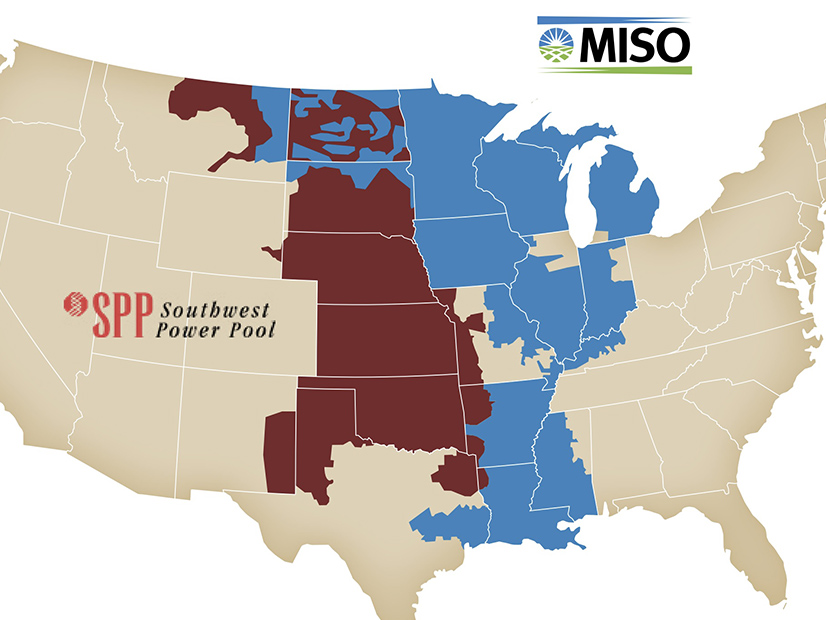MISO and SPP stakeholders expressed their consternation Friday over the RTOs’ proposed cost allocation for their interregional transmission planning initiative designed to ease overloaded generator interconnection queues.
The discord arose during a workshop over allocating costs for the grid operators’ Joint Targeted Interconnection Queue (JTIQ) study.
MISO and SPP plan to assign 90% of the $1 billion JTIQ portfolio to interconnection customers and the remaining 10% to an aggregate of their load. The RTOs said they will allocate a fixed, per-megawatt charge to interconnection customers that affect a facility in the neighboring region to pay for the portfolio. (See MISO, SPP Propose 90-10 Cost Split for JTIQ Projects.)
The RTOs are proposing a 5% distribution factor (DFAX) impact threshold on a neighboring system before interconnection requests are considered in a JTIQ-affected system zone and therefore, subject to transmission-cost sharing.
“We want to ensure the cost related to these JTIQ projects … are certain and reasonable,” Clint Savoy, SPP’s manager of interregional strategy, said during the workshop. He said the RTOs continue to believe that a 5% DFAX results in the most equitable cost allocation among interconnecting generation along their seam.
Stakeholders responded by saying MISO and SPP haven’t provided enough analysis that the 5% criterion is the best route.
The staffs said when they employed a 10% distribution factor, generation eligible to share in transmission costs dropped by nearly 60%. When the factor was increased to 15%, eligible generation plummeted by about 80%, making network upgrade costs untenable for the remaining interconnecting generation.
“If you make the zone too small, you could potentially, I think, incent siting generation outside of the zone,” Savoy said.
Some stakeholders repeated calls for an 80-20% split between generation and load assignment. They said load stands to benefit more than the 10% portion of JTIQ transmission costs.
North Dakota Public Service Commission Chair Julie Fedorchak said the 90-10 generation-load cost-allocation split is almost moot because generators will bake their JTIQ upgrade costs into customer bills.
“Those costs will ultimately be paid by the load,” she said.
MISO and SPP are also proposing another regional study for generation projects that: either have a 10% or greater DFAX impact on the neighboring system or who affect a certain number of the neighboring RTO’s substations, based on voltage rating. The RTOs said the study is necessary to monitor new local constraints caused by the incoming generation not covered by the major JTIQ transmission projects. When that happens, the host RTO plans to coordinate with the other RTO and transmission owners to “formulate a mitigation plan to alleviate the identified localized constraints.”
Clean Grid Alliance’s Natalie McIntire said stakeholders have “discomfort” with the cost-allocation proposal because MISO and SPP cannot provide an understanding of the overall costs that new generation will shoulder.
“It’s hard to know how all of these pieces will fit together and whether the result is going to be workable for interconnection customers and will result in viable projects,” she said.
Savoy said though he knows stakeholders would prefer a predicted range of costs, that’s “impossible” to provide at this point.
“This is an incremental step forward. We can’t give you complete cost certainty,” he said. However, Savoy said the JTIQ allocation should lower interconnection customers’ costs and asked stakeholders to at least give the RTOs a chance to improve the process.
David Kelley, SPP’s director of seams and market design, said interconnection customers splitting the costs of larger, “backbone projects” that allow mass interconnections is preferrable to the grid operators’ current affected system study process, where often high-priced network upgrades are designated to individual generation projects.
“We have to come up with a way to fund the transmission needed in this area,” Kelley said. “Basically today, we have an area that generators cannot develop in.”
“We are in agreement that the status quo sucks,” National Grid Renewable’s Rafik Halim said.
Invenergy’s Arash Ghodsian said he was supportive of the initial design but asked for a better explanation of the assumptions of proposed cost assignments’ mechanics.



